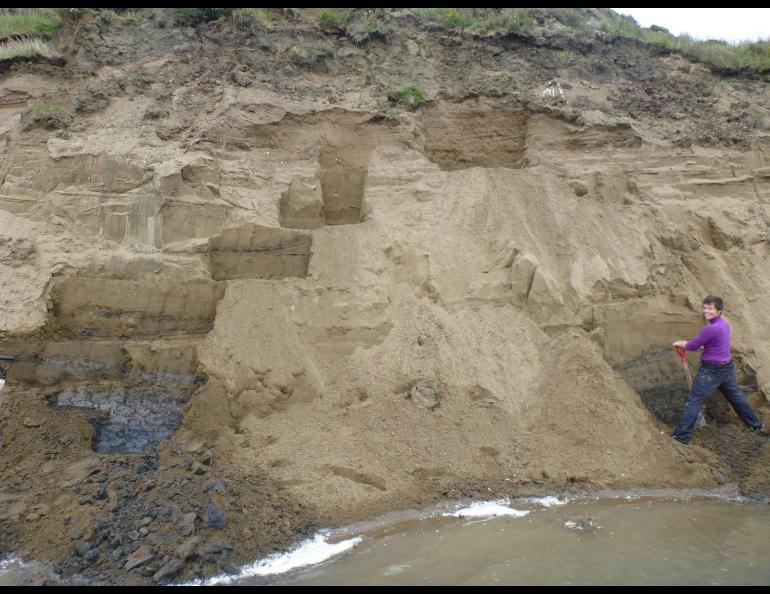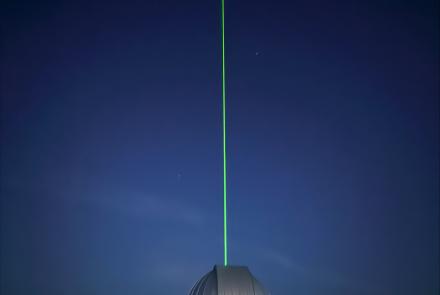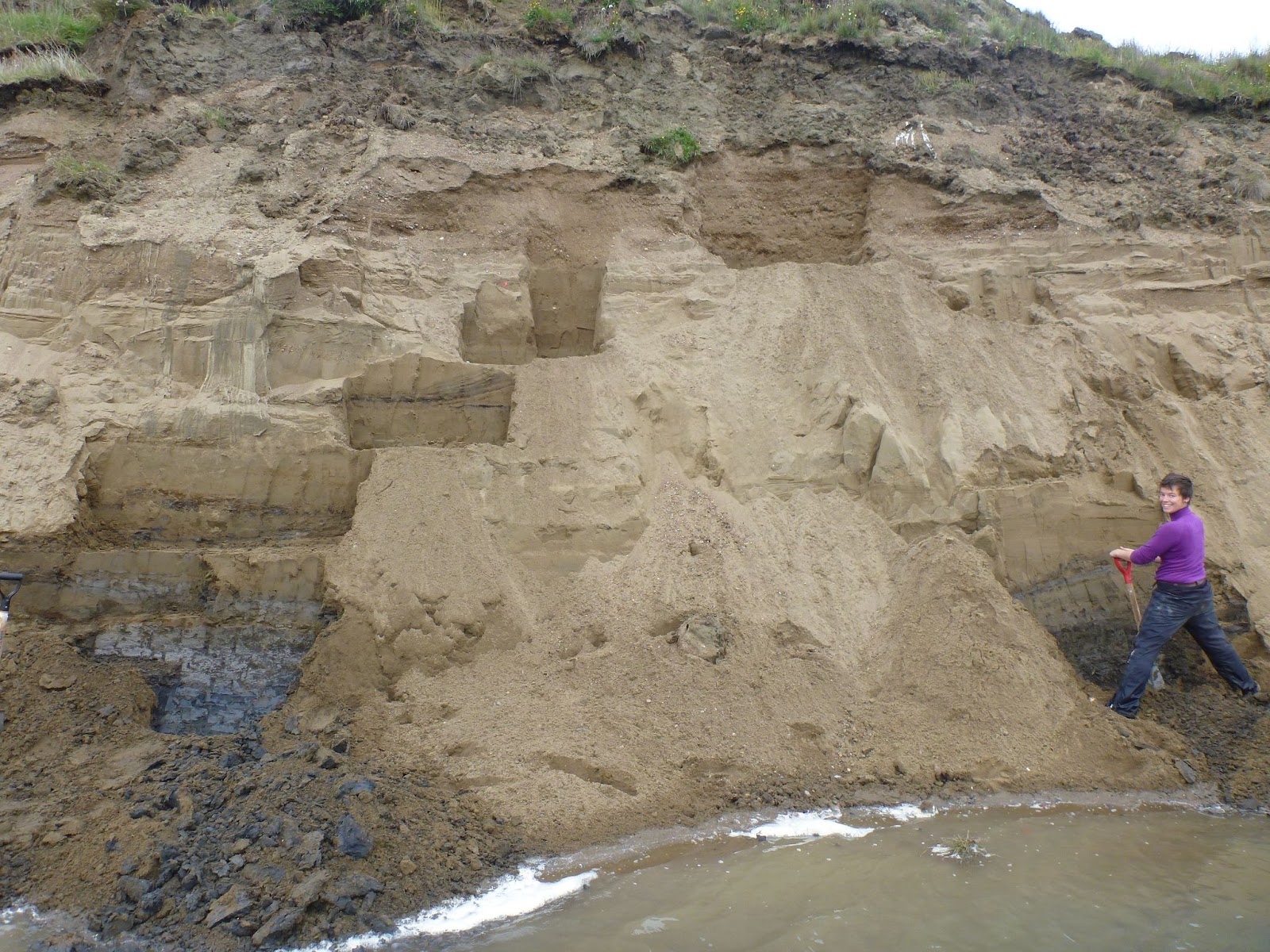
UAF scientists to hunt for clues about Arctic Ocean glaciation
Evidence indicates a thick ice sheet, not annual sea ice and icebergs, covered the Arctic Ocean at some point during the last 140,000 years. Now, University of Alaska Fairbanks scientists will be looking for more geologic proof of the ice sheet’s existence, sources, behavior and extent.
UAF Geophysical Institute scientists will focus on the Beaufort and Chukchi seas region, both offshore and onshore.
They hope to discover the extent of glaciation and improve understanding of the timing of glacial advances and retreats. Those cycles are thought to have occurred approximately 140,000 to 70,000 years ago, a period known as the mid- to late Pleistocene Epoch.
“The story of the Arctic Ocean is much more complicated than we may have originally thought and involves processes that we haven’t really considered before,” said Louise Farquharson, a research assistant professor at the UAF Geophysical Institute and the lead investigator.
Farquharson is working with UAF geophysics professor Bernard Coakley, who specializes in the history and formation of the Arctic Ocean, and research associate professor Andy Aschwanden, who studies glacier and ice sheet responses to atmospheric and oceanographic changes.
The National Science Foundation is funding the two-year project.
The researchers will build a geographic information system database of existing marine and terrestrial geologic evidence that could relate to a 1-kilometer thick glacier in the Beaufort-Chukchi region. Researchers will use that database to test the hypothesis that glaciation was extensive in the western Arctic Ocean at several points during the late Pleistocene.
A second component would use that database to model what type of climate would have allowed the initial glaciation and subsequent advances and retreats. That will also give scientists information about the main ice sources that contributed to the buildup.
The scientists hope to obtain additional funding for that research.
Knowledge gained through the two research efforts can improve understanding of how climate change affects today’s high-latitude ice sheets, Farquharson said.
Earth now has only two ice sheets, both of them high-latitude: Greenland and Antarctica. The two sheets cover 3% of Earth’s surface and 11% of the planet’s land. During glacial periods, ice sheets covered up to 8% of Earth’s surface and 25% of the land.
Offshore evidence to be included in the database includes seafloor and ridge scour marks, ocean core samples, bathymetric surveys and sonar data. Onshore evidence includes large boulders known as erratics and old shoreline ridges caused when ice pressing down on the landscape caused the ocean coast to move inland.
Finding onshore evidence is a “bit more complicated,” Farquharson said.
“That’s because we’re not really sure how far on land this Arctic Ocean glacier came, if at all,” she said. “But what we do see are these huge glacial erratics, big boulders up to the size of a car, deposited across the North Slope. There isn’t really a good mechanism for them being placed there other than through glacial transport and deposition.”
One theory states that ice streams flowing from the Canadian archipelago and feeding an Arctic Ocean glacier carried the boulders, which were left behind as the glacier retreated. An ice stream is an area of an ice sheet or ice cap that flows faster than the surrounding ice.
The new project builds on research of recent decades.
Some of that research comes from Coakley, who co-authored a 2001 paper offering evidence of glaciation rather than the then-prevailing view that only annual sea ice and icebergs covered the Arctic Ocean. That paper described glacial scouring and shaping of the seafloor and large-scale erosion of submarine ridge crests indicative of glacier movement.
That prior work has added to the Arctic Ocean glaciation hypothesis first presented by British glaciologist John Mercer in 1970. Mercer based his hypothesis on commonalities between the modern-day Arctic Ocean and the former sea of West Antarctica now occupied by an ice sheet.
Mercer’s hypothesis has gained traction in the past decade as more Arctic Ocean data has been able to be collected due to advances in technology and the reduced presence of sea ice. Research in the mid- to late 1990s and early 2000s by others found evidence of glacial ice grounding and erosion.
A 2016 paper by Swedish marine geologist Martin Jakobsson provided new evidence of ice-shelf groundings in the central Arctic Ocean. Jakobsson concluded that new data seems to suggest that ice sheet centers existed on the Chukchi or outer East Siberian shelf or both and that the northern East Siberian Islands contained evidence of glacial impacts.
Farquharson and Coakley also hope to test the hypothesis that Arctic Ocean glaciation occurred even as glaciers at lower latitudes receded. Scientists believe, based on geologic records, that the contrasting trends arose from differences in the moisture available for snow and ice formation.
Farquharson led research that produced that finding in 2018. UAF colleagues Daniel Mann of the Department of Geosciences, Pamela Groves of the Institute of Arctic Biology and Ben Jones of the Institute of Northern Engineering, along with scientists from Utah State University and in Germany, are co-authors on that research.
• Louise Farquharson, University of Alaska Fairbanks Geophysical Institute, 907-474-5623, lmfarquharson@alaska.edu
• Rod Boyce, University of Alaska Fairbanks Geophysical Institute, 907-474-7185, rcboyce@alaska.edu





